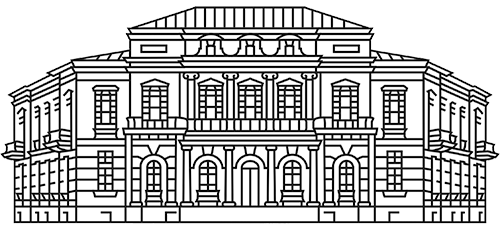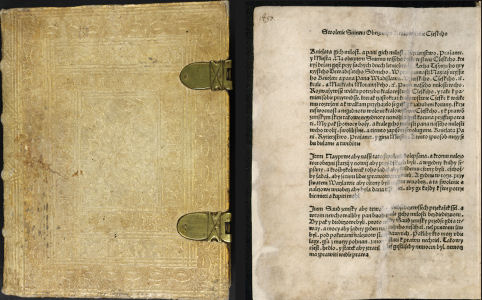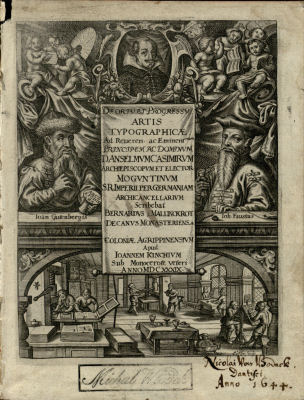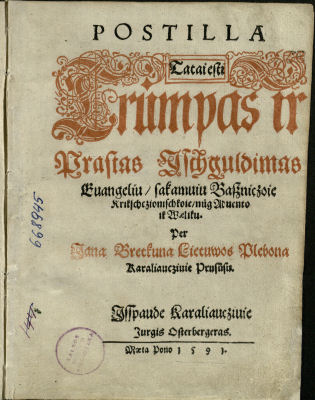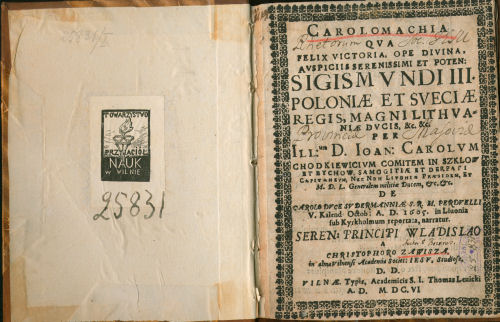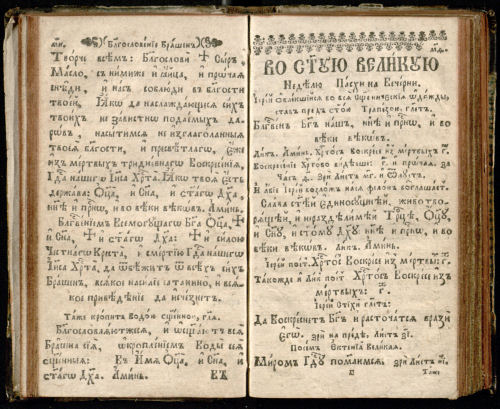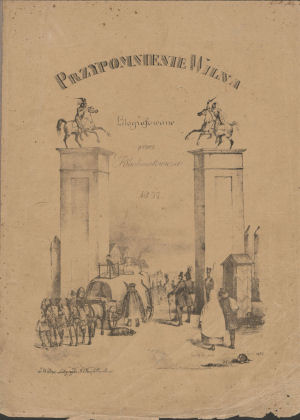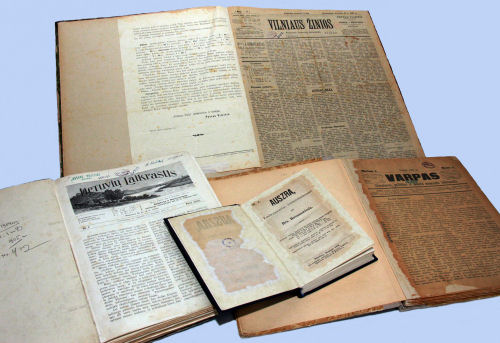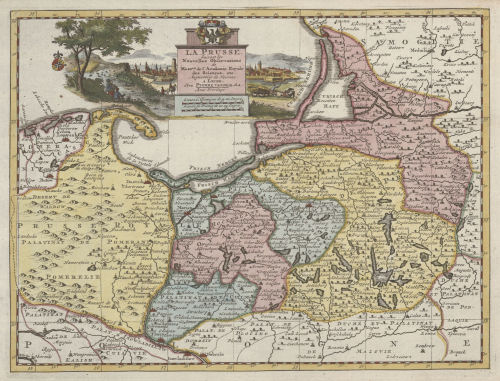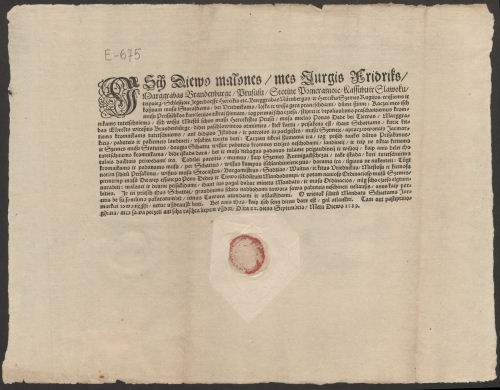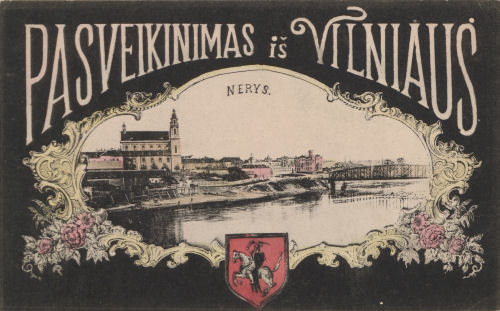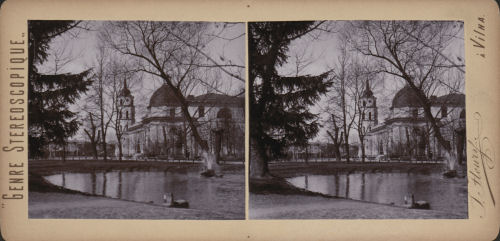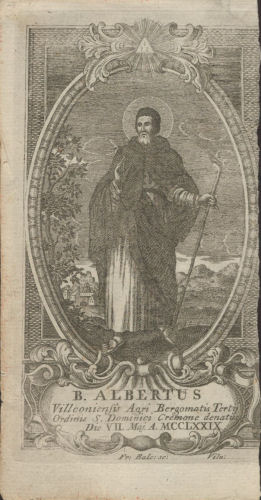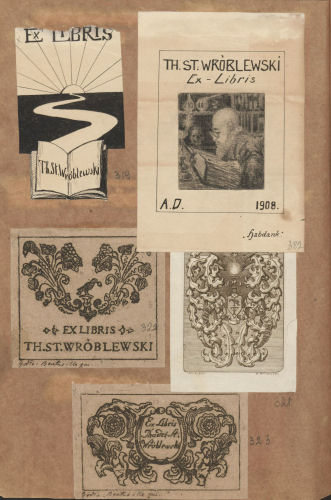Special Collections
The holdings of the Rare Books Department contain about 460 thousand of various itemss: books, cartographic publications, art albums, engravings, photographs, ephemera, microfilms, etc. They are divided into different collections by type, topic, and chronology. In the Library’s electronic catalogue, the holdings of the Rare Books Department are marked as CIM, and the separate holdings of the Old Periodicals Unit are marked as SPER. Materials from the special collections can be searched for, and requested, through the electronic catalogue, as well through the card catalogues located in the Tadeusz Wroblewski Reading Room.
The holdings of the Library include 67 incunabula printed in 1471–1500. The most valuable of these are two unique items, “Regulae cancellariae” by Pope Alexander VI (Rome, no earlier than 1495-08-08; digital copy of the book) and “Artikule snĕmovní z roku 1497” (Prague, 1497; article about the book ). The Library’s incunabula collection also includes the oldest books held by memory institutions in Lithuania, “Oratio ad Sixtum IV; Oratio ad Ferdinandum regem” by Johannes de Aragonia (Rome, after 1471-12-19). The collection is notable for its language diversity: in addition to books in Latin, it contains those in Czech, Church Slavonic, German, Ancient Greek, and Italian.
The collection of books published in various European countries consists of 63 thousand titles, the majority of which were printed in the 18th century (about 36 titles) and the 17th century (about 23 titles). While most books from the 16th-17th century are in Latin, books in French gain dominance in the 18th-century part of the collection. The thematic composition of the publications is diverse, from theological writings and editions of the Holy Scripture to fictional, scholarly, and educational texts. As only part of the collection has been catalogued in the Virtual Library, searching for the publications may be conducted in other ways.
The collection of 16th-20th-century books in Lithuanian consists of more than seven thousand titles. They have all been catalogued in the Library’s electronic catalogue, some have been digitized and are now available in the Digital Archive. The earliest original Lithuanian book is “Postilė” (“Postilla”) by Jonas Bretkūnas (Königsberg, 1591). The collection boasts 12 unique books, including the only known extant copy of a booklet translated by Kristijonas Donelaitis, „Gromata apie ganyklų perdalijimo naudą“ (A letter from a farmstead owner to his peasants on the usefulness of pasture division, Königsberg, after 1769). This publication has been included in the UNESCO “Memory of the World” national register. It is also featured at the virtual exhibition Mnemosinės sodai: UNESCO „Pasaulio atmintis“ LMA Vrublevskių bibliotekoje (The Gardens of Mnemosyne. UNESCO’s “Memory of the World” at the Wroblewski Library of the Lithuanian Academy of Sciences).
Lituanica is all published matter concerning Lithuania that is not in the Lithuanian language. The Lituanica collection in the Library consists of more than ten thousand books. The geography of publishing the Lituanica books encompasses about 60 locations in various European countries. The majority of these books are from the capital of the Grand Duchy, Vilnius; fewer books are from cities of the Kingdom of Poland such as Warsaw or Cracow, the capital of Eastern Prussia, Königsberg; some German cities (Cologne, Frankfurt-om-n-Main) and other places (about the early Lituanica in the Library). Some of the books have been digitized and are now available in the Digital Archive. The collection boasts unique publications included in the UNESCO “Memory of the World” national register: a catechism by Jan Seklucjan (“Katechismu text prosti”, Karaliaučius, 1545), and a thesaurus by Fulgentas Dryjackis (Fulgenty Dryjacki) decorated with engravings by Aleksandras Tarasevičius (Aleksander Tarasewicz), (“Thesaurus sacratissimae vitae passionis praetiosissimi D. N. Iesu Christi”, Vilnius: Printing House of Vilnius Academy, 1682).
This collection contains 16th-20th-century books printed in Cyrillic outside Lithuania, as well as publications issued in Slavic countries in Russian and other languages (more on the formation of this collection). It consists of 1465 titles, 240 of which are printed in Cyrillic. The earliest books in the collection is the Book of Numbers from The Ruthenian Bible by Francysk Skaryna (Prague, ca. 1519). The Rossica collection includes a panegyric for Ivan Mazepa printed in Latin in Kiev, “The Capitolium of Perennial Glory ”, included in the UNESCO “Memory of the World” national register in 2019 (more on this publication).
This collection consists of more than 20 thousand publications on world architecture, visual and applied arts, oeuvre of various artists, world museums and library collections, as well as authorial books, and nature and photo albums. They are marked with letter A. The acquisition of these publications goes back to the first decades of the 20th century, the early period of the formation of the Wroblewski Library. Many of the albums in the collection are related to the culture and art of Lithuania.
The collection consists of 500 titles of miniature books 10 cm or less in height, published in the 19th-21st centuries. The smallest book in the collection is the microminiature book “Lietuvos spaustuvėms 475” (“The 475th anniversary of the Lithuanian printing houses”, 10 x 10 mm; call number: M-467) published by the Vilius Užtupas’ Publishing House in 1997.
The Old Periodicals Collection contains more than 7000 titles of newspapers and journals, including Lithuanian and Lituanica periodicals from the 19th-20th century (pre-1945); old and rare non-Lituanica preiodicals (pre-1800), Lithuanian emigree periodicals. Most of the collection consists of interwar newspapers and journals published in the Vilnius county in the Lithuanian, Polish, Belarusian, and Russian languages. The collection includes the first Lithuanian newspapers “Auszra” (“The Dawn”, 1883–1886), “Varpas” (“The Bell”1889–1905), and “Ūkininkas” (“The Farmer”1890–1905). The earliest journal in the collection is “Monatliche Unterredungen einiger guten Freunde von allerhand Büchern und andern annehmlichen Geschichten” (“Monthly Conversations with Some Good Friends…”, call number: P-021146) published from 1689 to 1698 in Leipzig and Toruń.
All the items from the Old Periodicals Collection have been catalogued in the Library’s electronic catalogue, some have been digitized and are available in the Digital Archive.
The collection of maps and atlases consists of more than 6000 titles of documents published over the time period from the 16th century to these days. Topographic maps of Lithuania make a notable part of cartographic heritage. The most important maps may be viewed at the Digital Archive, and at the projects “Forgotten Vilnius” and “Topographic Maps of Lithuania for 1914-1945”. The collection includes a unique lithographic “Žemlapis lietuviškai latviško krašto” (“Map of the Lithuanian-Latvian Land”, 1900) published in St. Petersburg by A. Macijauskas at the time of the Lithuanian press ban, which has a handwritten dedication from the publisher to Jonas Basanavičius. More information on this map is offered in this lecture.
This is a collection of 16th-20th-century printed edicts issued by the Prussian authorities (771 title). The documents are in various languages – Lithuanian, German, Polish, and Russian, the majority of them being in German. Of the 94 Lithuanian-language edicts, 61 are unique or at least very rare and held only by this Library. Some edicts have been digitized and are available in the Digital Archive, all of them have been catalogued in the Library’s electronic catalogue. The earliest Lithuanian-language edict in the collection was printed in 1589 in Königsberg.
The collection contains about 15 thousand postcards, the majority of which feature cities of various countries – architecture, monuments, landscapes. The earliest of them date back to the late 19th century. An important part of the collection consists of greeting cards. Lithuanian-themed postcards are especially popular. The collection is annually augmented by new items. Some of the old postcards have been digitized and are available in the Digital Archive. As only some of these materials have been catalogued in the Library’s electronic catalogue, searching for them can be carried out in other ways.
The collection consists of about 31 thousand photographs, from the earliest daguerreotype (1840-1850) to today’s drone photographs. The items include works by acclaimed Vilnius photographers such as Abdon Korzon, Józef Czechowicz, Stanisław Fleury, and Jan Bułhak, as well as works by the most prominent photographers of other Lithuanian cities. The photographs feature city landscapes, various celebrations, portraits. Part of the collection has been digitized and is available in the Digital Archive. As relatively few of the items have been catalogued in the Library’s electronic catalogue, searching for them can be carried out in other ways.
The collection consists of about 7000 copper and steel engravings, lithographs, and works created with other techniques by 16th-21st-century artists from Lithuania and other countries, including numerous holy pictures. Among the items there are artworks by engravers of Lithuania such as Franciszek Wacław Balcewicz, the Perli family, Józef Ozębłowski, Izydor Weiss, instructors of the Vilnius Stephen Batory University and graphic artists of the second half of the 20th century. The engravings reflect European and Lithuanian history; some of them feature portraits of Polish and Lithuanian rulers, noblemen, scientists, and artists; some depict famous artworks. As only some of these materials have been catalogued at the Library’s electronic catalogue, searching for them can be carried out in other ways.
The collection consists of about 8000 bookplates dating from the 18th to the early 21st century. The items include works by artists from Lithuania and other countries, prints, stamps, and inscriptions by owners addressed to various individuals as well as to personal and institutional libraries. The accumulation of the bookplate collection began in the early 20th century. Its core is made up by the personal collection of Franciszek Tyczkowski, notable for graphic images created especially for the Wroblewski Library and Tadeusz Wróblewski. In 1985, the Library’s holdings of bookplates were augmented by the addition of the personal collection of Stanislovas Pilka. In this century, the holdings were further enriched by bookplates from personal collections of Antanas Rimvydas Čaplinskas and the artist Vladimir Vinogradov, as well as the collection focusing on the 1863-1864 uprising, donated by the Gariūnai Business Park. Some of the bookplates have been digitized and are available in the Digital Archive.
